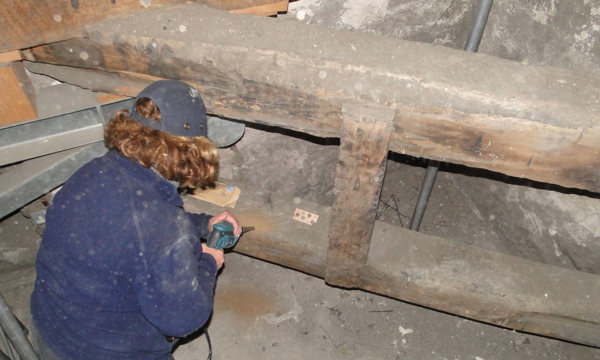Historic Environment Scotland (HES) provided funding for the South East Scotland Oak Dendrochronology project (SESOD), led by Dr Coralie Mills, to investigate the remarkable five-storey timber frame within the bell tower of St Giles’ High Kirk on the city's Royal Mile, which is part of the Old and New Towns of Edinburgh World Heritage site. The aim of this research was to recover valuable tree-ring data and determine the date of its construction. While founded in 1124, the church has undergone many additions and alterations over time, particularly in the 19th century.
Dendrochronology – the scientific method of dating tree rings to the exact year they were formed – was conducted on samples taken from a selection of oak timbers in the bell-frame, which has refined the probable date for completion of the St Giles’ bell tower to between 1460 and 1467, when the church achieved collegiate status from Pope Paul II.
The testing was able to establish two felling dates for timber in the frame - in the winters of 1453/54 and 1459/60. The research also revealed that the timber was sourced from one of the last remaining reserves of old growth oak timber in Scotland, the Royal Forest of Darnaway, in Morayshire, and that many of these trees would have been over 300 years old when felled.
Dr Coralie Mills, the dendrochronologist who carried out the work, said:
Discovering the date and provenance of the timbers in the tower at St Giles’, and allowing a new insight into the medieval history of our native woods, has been a highlight of my career as a dendrochronologist in Scotland.
“The mid-15th century was a pivotal time when Scotland turned to Scandinavia for most of its timber supply, but this research shows that Darnaway still had reserves of old growth oak, by then a very scarce and valuable resource in Scotland. Furthermore, the St Giles’ timbers match closely with other material from reused timber in the Chapel Royal at Stirling Castle, which is also thought to have come from Darnaway.
“These results enhance our understanding of St Giles’ construction history and provide valuable insights into the medieval timber supply in Scotland.”
Dr. Kirsty Owen, Deputy Head of Archaeology at HES said:
”We’re delighted to have supported the work of the SESOD project through our archaeology grants programme, which is part of our ongoing commitment to raise the profile of archaeological science and its practical role in the conservation of our heritage.
“This discovery at St Giles’s demonstrates that dendrochronological research has the potential to significantly enhance our understanding of our historic buildings, which in turn will assist in their conservation.”
John Andrew, Member of the St Giles’ Kirk Session and Convenor of the committee responsible for the building fabric, said:
“The investigation and subsequent discovery of the history of the ancient timbers in the crown tower at St Giles’ has uncovered another key element in the fascinating history of this great and iconic building.
“The continuing research into the history of St Giles’ will continue to improve our understanding on how the building was constructed and will inform how the building will be conserved, and maintained for generations of worshipers and visitors in the future.”
John Lawson, Edinburgh’s City Archaeologist and supporter of the project. said:
This fascinating research into the original timber used to build the bell tower of St Giles’ has given us new insight into the Kirk, a building that we thought we knew so well.
“This has been an incredible piece of work which has helped shed light on the long-asked question of exactly when and how the present tower was constructed. St Giles’ Kirk has changed in many ways over the last 900 years and until now various dates had been given for its construction from 14th century onwards. This research now confirms a 15th century date and highlights the importance of undertaking archaeological investigations in our historic buildings. “
About Historic Environment Scotland (HES)
- We are the lead public body charged with caring for, protecting and promoting the historic environment. We will lead on delivering Scotland’s first strategy for the historic environment, Our Place in Time.
- Historic Scotland, Scran, Canmore, The National Collection of Aerial Photography (NCAP), The Engine Shed, Stirling Castle and Edinburgh Castle are sub-brands of HES.
- View our press pack and keep up to date by registering for media release email alerts. If you wish to unsubscribe, please contact us.
Follow Historic Environment Scotland
Twitter: @HistEnvScot | @welovehistory
Facebook: @HistoricEnvScotland | @VisitHistoricScotland
Instagram: @HistEnvScot | @historicscotland
For further information, please contact:
Dean Hendry
Historic Environment Scotland Media Office
Direct line: 0131 668 8714
Mobile: 07468 759 137
communications@hes.scot

